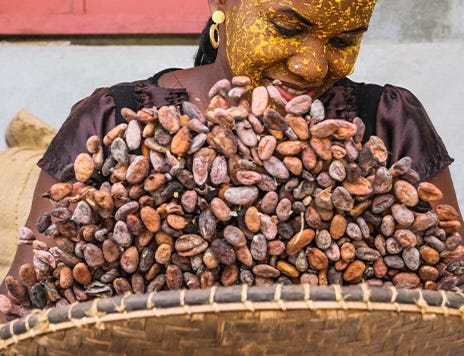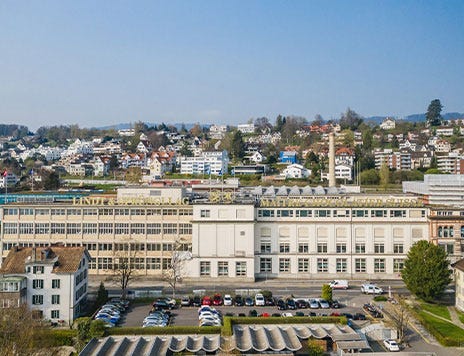As a Lindt & Sprüngli group company, we at Ghirardelli comply with the group's sustainability standards.
High Quality Cocoa is at the Heart of Our Chocolate
We, at Lindt & Sprüngli, produce our own cocoa mass, which is a key ingredient for chocolate production. This allows us to oversee the entire production process: from the selection and sourcing of cocoa beans to the cocoa mass (also called cocoa liquor) and the finished product. This means our chocolate is produced from 'bean to bar'.
Since 2020, we have been sourcing 100% of our cocoa beans through our Farming Program (excluding Russell Stover). We extended the Farming Program to include cocoa butter in 2021 and cocoa powder in 2022. Our aim is to source 100% of cocoa products which includes beans, butter, powder, and chocolate mass through the Lindt & Sprüngli Farming Program or other sustainability programs by 2025.


Our Target
We aim to source 100% of cocoa products (beans, butter, powder, and chocolate mass) through the Lindt & Sprüngli Farming Program or other sustainability programs by 2025. In the reporting year 2023, we sourced a total of 68.2% of cocoa bean equivalents through our Farming Program.


Farming Program Farmers
A total of 131,000 cocoa farmers from our cocoa origin countries are part of the Lindt & Sprüngli Farming Program.


Our Investments
In 2023, we invested a total of CHF 29.8 million into cocoa sustainability, of which CHF 26.8 million was paid to cocoa suppliers for operating our Farming Program.
Empowerment Through Education
Since 2008, Lindt & Sprüngli has built or refurbished a total of 50 schools across all origin countries benefiting approximately 9,700 children.


Clean and Safe Water Access
Approximately 158,000 community members benefit from 250 drinking water systems and boreholes built and functioning since 2008.


Support for Farmers and Their Families
990 passionate field staff work with cocoa farmers in the Lindt & Sprüngli Farming Program.


Our Commitments for a Better Tomorrow


Rural Development
We aim to source 100% of cocoa products – beans, butter, powder, and chocolate mass – through the Lindt & Sprüngli Farming Program or other sustainability programs by 2025.


Biodiversity and Ecosystems
We aim for no deforestation in cocoa with a target date of December 31, 2025, and to work towards the elimination of deforestation in our other key deforestation linked supply chains (palm oil, soy, and paper and pulp-based packaging).


Product Quality and Product Safety
We are committed to full and continuous compliance with Lindt & Sprüngli’s quality and food safety standards.


Responsible Sourcing
We aim for 80% of our sourced volumes of raw and packaging materials bearing significant sustainability risks to be covered by a responsible sourcing program by 2025.


Chocolate Waste Reduction
Our goal is to halve our chocolate waste in the production process per ton produced by 2025.


Enabling and Motivating Working Environment
We aim to increase the representation of women in senior leadership to 40% by 2025.


Climate
We aim to achieve near- and long-term science-based targets and reach net-zero greenhouse gas emissions across the value chain by 2050.


Transparent and Responsible Communication
We are committed to not targeting children under 16 years old in our advertising, encouraging responsible consumption, providing transparent nutritional information and adhering to applicable national and international laws.


Water
We aim to achieve a 10% reduction of municipal water withdrawal for use in our production processes (versus 2019), per ton produced, and to develop an integrated water roadmap by 2025.


Respecting Human Rights
We are committed to respecting human rights, as set forth in our Human Rights Policy. Our human rights commitment is guided by international conventions and standards.


Occupational Health and Safety
We aim to continuously reduce our safety risks to achieve our long-term vision of zero lost time accidents.


Against Corruption
We do not participate in any corrupt or anti-competitive behaviour.


Packaging
We aim to design over 90% of packaging to be recyclable by 2025.


Responsibly Sourced Hazelnuts
Hazelnuts are a key ingredient in some of our chocolate products. Learn how we ensure that our hazelnuts are sourced through sustainability programs.


RSPO-Certified Palm Oil
We understand the impact that the uncontrolled cultivation of palm oil can have on rainforests and biodiversity. That is why we monitor its use in our products and are committed to only purchasing sustainable RSPO certified palm oil.


Recyclable Packaging
We are trying to strike a balance between visually appealing packaging and quality aspects associated with product protection. We proactively challenge our entire packaging portfolio and endeavor to reduce the amount of packaging materials used, increase the recycled and sustainably certified content, and achieve recyclability We try to reduce packaging materials and increase the use of recyclable materials.


Emissions Reduction
EWith our commitment to science-based targets, we bring our ambitions in line with the goals of the Paris Agreement, which aims to limit the global temperature increase to 1.5°C above pre-industrial levels.


